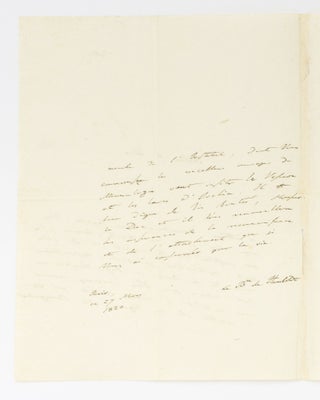An autograph letter signed 'Le Bn de Humboldt', addressed to 'Monsieur le Duc' (likely Nicola Filomarino, duca della Torre), dated 'Paris, le 27 Mars 1820'
Small quarto, 2 pages, with a conjugate blank leaf.
Thin strip of tissue-paper on the outside rear page, and minimal loss to this blank leaf near the centre of the hinge (both as a result of having been mounted in, then removed from, an album); light creases where folded in four for posting; in excellent condition.
Humboldt writes to introduce the geologist Alexandre Brongniart, remembering with gratitude the assistance rendered by le Duc to himself and his friends and collaborators, [Louis Joseph] Gay-Lussac and [Christian Leopold von] Buch. He hopes that M. Brongniart, 'l'homme célèbre', who wishes to visit Vesuvius and the lava flows of Ischia, will be afforded similar kindnesses. Nicola Filomarino, duca della Torre and principe di Boiano, devoted much of his scientific career to the study of Vesuvius and the volcanology of Campania. In August 1805 he accompanied Humboldt to the crater of Vesuvius, with Humboldt's journal recording that his observations were made with the aid of the Duke's chronometer ('Voyage de Paris en Italie avec Gay Lussac, 1805', f42v; accessed via Edition Humboldt Digital). Our thanks to Professor David Pyle for suggesting della Torre as the addressee of this letter and drawing our attention to the relevant passages in Humboldt's journal. Alexandre Brongniart (1770-1847) was a French chemist, mineralogist, and zoologist, who collaborated with Georges Cuvier on a study of the geology of the region around Paris. In 1800 he was appointed director of the porcelain manufactory at Sèvres, a position he held until his death 47 years later. Alexander von Humboldt (1769-1859) was a Prussian geographer, naturalist and explorer. His work on volcanology was important in forming his general understanding of physical geography. 'After five years exploring the Andes and Amazonian forest, Humboldt returned to Europe in August 1804. A year later he traveled, together with Leopold von Buch and Joseph Louis Gay-Lussac, to Italy. Visiting Naples, the three geologists repeatedly climbed Mount Vesuvius and witnessed the eruption of August 1805. … Humboldt noted that volcanoes are not distributed randomly, but found in long chains of mountains, like the Andes. He could not know that volcanoes follow the borders of the large tectonic plates. However, he made some correct observations. He speculated that where the rocks are fractured by tectonic movements (like by an earthquake) magma could more easily rise to the surface. This is in part true, as plate boundaries are weak zones, and the subduction and melting of rocks feeds explosive volcanism, as found in the Andes. Humboldt would popularize the idea that volcanoes are important in creating and forming landscapes in many public lectures over the years' (David Bressan: 'Alexander von Humboldt's Contributions to Geology', published in 'Forbes', 14 September 2019).
Item #96984
Price (AUD):
$1,750.00


